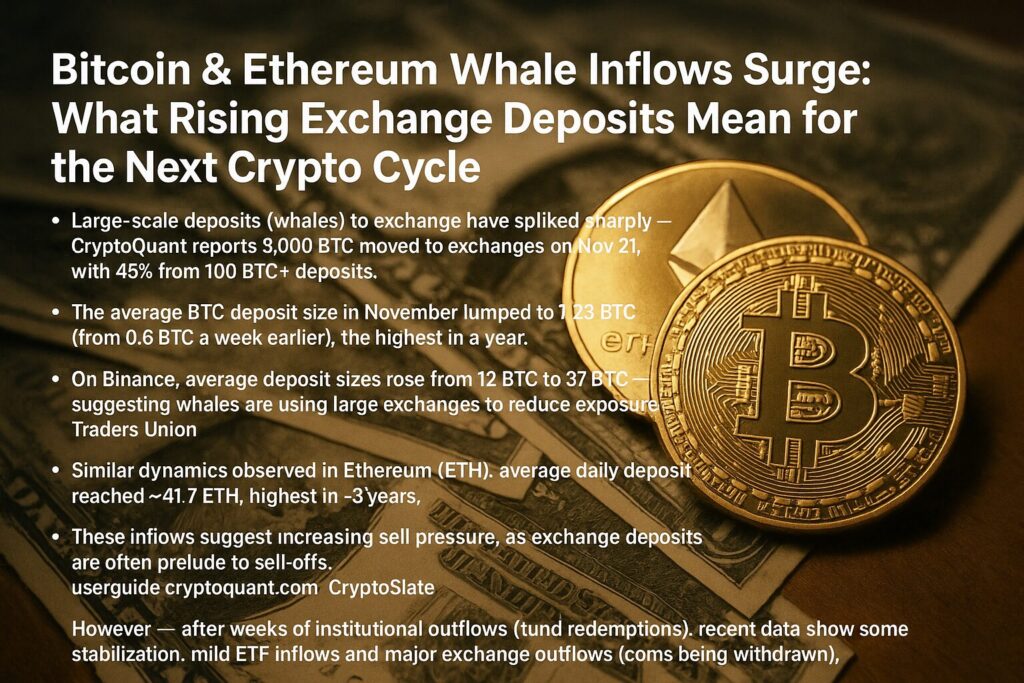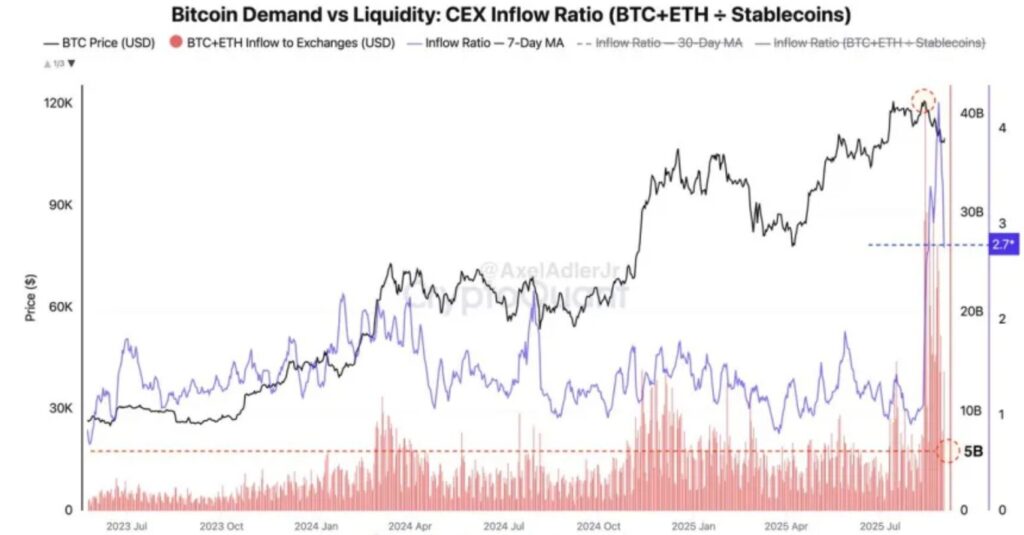
Main Points :
- Large-scale deposits (whales) to exchanges have spiked sharply — CryptoQuant reports 9,000 BTC moved to exchanges on Nov 21, with 45% from 100 BTC+ deposits.
- The average BTC deposit size in November jumped to 1.23 BTC (from 0.6 BTC a week earlier), the highest in a year.
- On Binance, average deposit sizes rose from 12 BTC to 37 BTC — suggesting whales are using large exchanges to reduce exposure.
- Similar dynamics observed in Ethereum (ETH): average daily deposit reached ~41.7 ETH, highest in ~3 years.
- These inflows suggest increasing sell pressure, as exchange deposits are often prelude to sell-offs.
- However — after weeks of institutional outflows (fund redemptions), recent data show some stabilization: mild ETF inflows and major exchange outflows (coins being withdrawn), hinting that forced selling may be easing.
- The currently depressed price levels (BTC below its active realized price) may make the next few weeks critical: if whales hold or start buying, a rebound could follow.
Surge in Whale Exchange Deposits: What the Data Shows
Recently, on-chain analytics firm CryptoQuant flagged a sudden spike in large-scale cryptocurrency deposits to exchanges. On November 21 alone, about 9,000 BTC was transferred into exchange wallets — and notably, 45% of that came from deposits of 100 BTC or more, a proportion far above typical levels.
This surge drove the average BTC deposit size in November to 1.23 BTC, up from just 0.6 BTC only a week prior. That is the highest monthly average in a year. On major exchange Binance, the increase was even starker: average deposit size rose from around 12 BTC at the beginning of the month to roughly 37 BTC in recent days. This suggests that large holders — “whales” — are consolidating their BTC on exchange platforms, likely preparing for sale or reducing exposure.
Meanwhile, similar patterns are observed for Ethereum: as ETH prices dipped to around US$2,900 – $2,600, the average daily ETH deposit to exchanges surged to ~41.7 ETH, the highest level in nearly three years.
These inflows are part of a broader trend of heightened exchange activity: altcoin deposits (not just BTC and ETH) have also been elevated since mid-2025.
Taken together, the data suggests that large investors are preparing for potential sell-offs. In traditional on-chain interpretation, rising exchange inflows — especially driven by whales — are regarded as a bearish indicator.
Why Whale Inflows Matter: Market Dynamics & Risk of Dumping
To appreciate why whale behavior is critical, we need to understand the role of “exchange inflows” in crypto markets. As described by CryptoQuant, when coins flow into exchange wallets, it’s often a precursor to selling — either to realize profits or to hedge against further price drops. Conversely, when coins are withdrawn from exchanges into private wallets (outflows), it’s typically a bullish sign, indicating holders are moving toward long-term “HODL.”
Whales — typically holders of hundreds to thousands of coins — have outsized influence. According to a guide on “Bitcoin whales,” addresses holding 1,000 BTC or more (or even 100+ BTC) are considered whales, and their activity often presages significant market moves. In 2025, the number of such “whale” addresses (1,000 BTC+) has reportedly risen anew, indicating renewed institutional or high-net-worth engagement.
When whales deposit large amounts to exchanges, it’s widely interpreted as preparing for liquidation — either to lock in gains or reduce exposure. As one analysis puts it, “whale selling beat their efforts” in recent downward market moves.
Given the sheer volume large holders control, even a modest portion cashed out can exert significant downward pressure on price; this can trigger panic among smaller investors, further amplifying volatility. For traders or investors looking for entry points — such movements can create both risk and opportunity.
Not Just BTC — Ethereum and Altcoins See Similar Pressure
While much focus lands on BTC, the same pattern extends to Ethereum (ETH) and, to a lesser extent, altcoins. CryptoQuant noted that ETH inflows — dominated by large deposits — surged as ETH approached ~$2,600–$2,900. The average daily deposit of ~41.7 ETH stands as a 3-year high.
Altcoin exchange activity has also increased, suggesting that the trend of liquidation or repositioning isn’t limited to BTC. CryptoQuant’s data shows deposit counts for altcoins exceeded 40,000 transactions per day since July 2025, with periodic peaks (e.g., ~78,000 on October 17).
These developments reflect broader deleveraging or repositioning across multiple crypto assets, rather than an isolated Bitcoin event. For investors exploring new assets or altcoins, they underscore that macro-market pressure currently affects broad swathes of the market.
Context: Institutional Outflows and Market Sentiment
Importantly, the spike in exchange inflows comes as institutional investors have been pulling funds out of crypto. According to a recent report, digital-asset funds saw US$1.94 billion in outflows last week alone — among the largest runs since 2018.
Most of those outflows came from Bitcoin and Ethereum funds: BTC funds lost roughly $1.27 bn, and ETH funds about $589 mn.
However, at the end of the week, there was a slight net inflow (about $258 mn) into crypto funds, and on-chain data simultaneously registered large outflows of BTC and ETH from exchanges — a pattern some interpret as indicating that forced selling may be abating, and some investors are beginning to re-accumulate or take self-custody.
This “calm after the storm” could mark a transitional phase: forced sellers may be exiting, while long-term oriented investors are quietly preparing for the next cycle.
Caveats: Data Distortions and the Need for Context
That said — caution is required when interpreting exchange inflow data. For instance, the analytics community has raised warnings that some recent “spikes” may stem from internal wallet migrations by exchanges — not external whale deposits. A notable example: on Nov 22, Coinbase moved large sums of BTC and ETH between cold wallets. On-chain tools initially flagged this as massive outflows (600,000–800,000 BTC), triggering alarm — but the reality was purely custodial housekeeping, with no coins leaving Coinbase’s control.
CryptoQuant itself acknowledged that such migrations distort exchange-reserve data, and promised adjustments once the migration process completes.
Thus, not all on-chain “inflows” should automatically be assumed to signal imminent dumping — context matters.
What This Means for Investors, Traders, and Blockchain Practitioners
For readers like you — those seeking promising crypto assets, potential income sources, or practical blockchain applications — the recent wave of whale activity and exchange flows offers both warning signs and possible opportunities:
- Heightened volatility: Large inflows suggest a risk of substantial sell-offs — meaning short-term price swings could be steep. Traders should approach with caution.
- Potential entry opportunity: If forced sellers have mostly exited, the current depressed prices (especially if BTC remains below realized cost) might represent a buying window for long-term holders or new entrants.
- Altcoin pressure: Because ETH and altcoins are also seeing elevated exchange flows, diversification away from BTC doesn’t guarantee safety.
- Long-term accumulation signal: Whale activity and institutional fund rotations may indicate a re-accumulation or repositioning phase — particularly if funds begin flowing back in and exchange outflows resume.
- Need for due diligence: Given potential data distortions (e.g., exchange internal transfers), on-chain signals should be cross-checked with additional data — exchange-reported reserves, wallet labels, and fund flow reports.

Conclusion: A Pivotal Moment — Watch the Whales, But Verify the Signals
The recent surge in large-scale exchange deposits of BTC and ETH marks a potentially pivotal phase for the crypto market. Whale activity is unmistakable, and for traders and investors alike, this is a time for heightened vigilance. On one hand, the flood of coins toward exchanges tends to precede sell-offs — a bearish sign. On the other, the wave of institutional outflows may be ending, and early signs of stabilization appear: exchange outflows, modest net inflows to funds, and possibly a re-accumulation under the radar.
For those hunting new crypto opportunities — whether in major assets like BTC/ETH or in promising altcoins — the coming weeks could offer attractive entry points. But navigating this terrain demands discipline, diversified strategy, and skepticism. On-chain data alone can mislead, especially when exchange wallet migrations or custodial reshuffling distort the picture.
In short: keep watching the whales — but don’t take every wave at face value.

